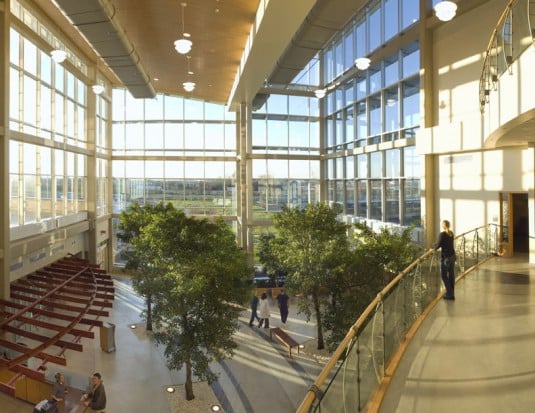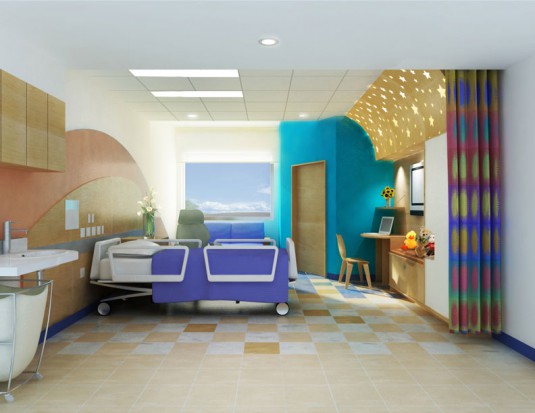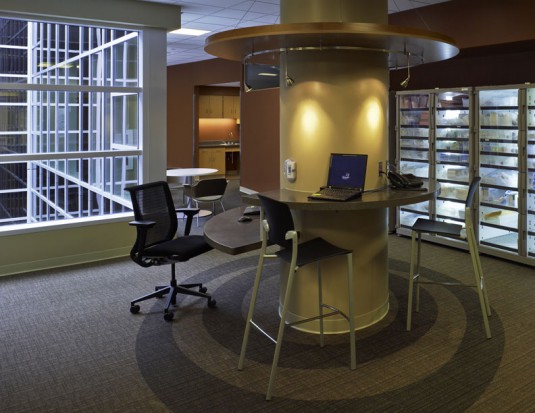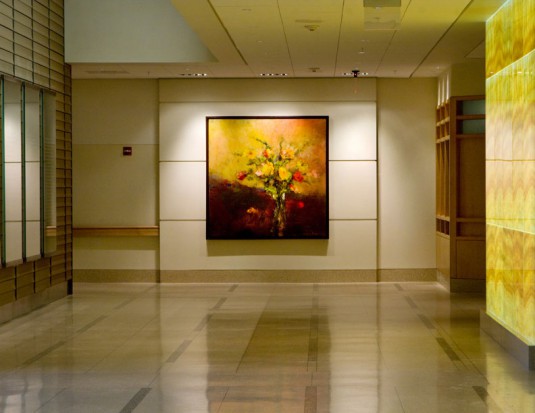
May 10, 2011
Q&A: Rosalyn Cama
When I heard that Rosalyn Cama, principal of the New Haven firm, CAMA, Inc., was about to speak at Lightfair (Philadelphia, May 17-19) I jumped at the chance to engage her in conversation about the relationship of light and health. My motivation was strictly personal. I’ve spent enough time in hospitals, both as a patient […]
When I heard that Rosalyn Cama, principal of the New Haven firm, CAMA, Inc., was about to speak at Lightfair (Philadelphia, May 17-19) I jumped at the chance to engage her in conversation about the relationship of light and health. My motivation was strictly personal. I’ve spent enough time in hospitals, both as a patient and frequent visitor, to know the dismal conditions in these sealed, dank, germ-ridden buildings where you go to get cured of what ails you, and can come away with some bug or another. And as someone who spends too much time staring at computer screens in darkened rooms and whose every cell is screaming for sunlight and fresh air, I, personally wanted to take advantage of Ros’ special learning as an interior designer, researcher, and consultant in the healthcare field (she is the author of Evidence-Based Healthcare Design, John Wiley & Sons, 2009). Hospitals, as I see them, are the extreme environments of our times. If we solve some of our health, safety, and welfare problems in these places we can begin to understand what it takes to design all kinds of healthy interiors. Here Ros talks about why lighting design is key to human health.
 The lobby of the Dublin Methodist Hospital project (Karlsberger/CAMA).
The lobby of the Dublin Methodist Hospital project (Karlsberger/CAMA).
Susan S. Szenasy: I’m happy to hear that you, a specialist in healthcare design and healing environments, will be speaking at Lightfair on May 18th. Firstly, as a long-time advocate of Evidence Based Design, can you explain what that term means to you?
Rosalyn Cama: Evidence-Based Design (EBD) is the process of basing decisions about the built environment on credible research to achieve the best possible outcomes. This process gathers intelligence from a variety of sources, maps a project’s vision, hypothesizes optimal outcomes, and measures results. It keeps the design team on track for the best solution derived from baseline data and easily opens possibilities for innovative next solutions.
To me, Evidence-based Design is just a means to an end. The goal is to realize design interventions that produce “Places of Wellbeing”. The path we use is Interior design that employs an evidence-based design methodology that focuses on better outcomes while improving the human experience and fostering wellbeing.
SSS: Your Lightfair topic, Lighting Design for Health and Healing, reminds me of how much work needs to be done in this area. Most of us have been in hospitals where the lighting has made us look and feel sicker that we thought we were. What’s your baseline advice on how to turn this awful trend around?
RC: It is all a matter of being informed. With the right understanding of how daylight, sun orientation, and circadian rhythms impact us as human beings sound decisions can be made about artificial lighting sources especially for interior occupants who do not have access to the out-of-doors. My presentation will include statistics from some basic studies that can begin an informed discussion with the stakeholders in the design process, about the power of understanding the effects of natural light qualities. Without this knowledge decisions are made only using artificial light calculations. But both halves of the story –artificial and natural light combined–have to be understood when calculating light levels in a healing environment.
 A patient room at the El Paso Children’s Hospital.
A patient room at the El Paso Children’s Hospital.
SSS: Can you cite some key data that proves the need for better lighting in healing environments?
RC: Yes, just a few examples from the stakeholder’s perspective: for the hospital administrator It will shorten the length of stay and reduce pain medications which have operational financial implications; for the patient It reduces stress/anxiety and lowers pain; for the client it improves sleep quality, for the patient as well as the staff, it also contributes to the reduction of medical error.
SSS: You’ll be talking about how lighting influences such things as pain, sleep, depression, length of hospital stay, and patient satisfaction. Will you share with me one or two of your most dramatic findings?
RC: If you properly light a path in complex buildings like healthcare facilities, accentuating landmarks where key decisions about direction need to be made, then a 604-bed-tertiary-care hospital can expect to save $222,000 a year in the hidden costs of people that are needed to give directions or others waiting for customers who get lost and spend time way-finding.
Access to natural light, just three hours during a shift, is one of the few physical attributes linked with higher staff satisfaction. Investments in locating staff- replenishment zones in areas that have access to daylight or bringing daylight into a unit could therefore reduce the cost of staff turnover . It costs approximately $62,100.00 to replace a nurse.
 The nurse perch at the Dublin Methodist Hospital project (Karlsberger/CAMA).
The nurse perch at the Dublin Methodist Hospital project (Karlsberger/CAMA).
SSS: In your experience, has the current interest in daylighting influenced patient well being?
RC: We are slow in this country to understand the importance of outcomes around lighting. On the Dublin Methodist Hospital project (Karlsberger/CAMA) we worked hard to increase access to daylight. The effects of that influence are being scientifically measured. Anecdotally, the quality of the interior experience is perceptibly different. The overall cost for construction was marginal. Georgia Tech is conducting studies. Stay tuned.
SSS: What is the one, big mistake designers make in combining daylighting with artificial lighting, from a human well-being point of view?
RC: Believe or not, many architects and developers are still not paying attention to the sun’s orientation in siting a building. The light levels on one side of the hall versus the other can influence how long you will recover, therefore need different artificial lighting adjustments. The sunny side of the building can offer 46% greater sunlight intensity, which will require 22% less pain medication with a financial gain of 21% reduction in the cost of those medications.
SSS: That’s pretty persuasive!
 The Smilow Cancer Hospital at the Yale-New Haven Hospital.
The Smilow Cancer Hospital at the Yale-New Haven Hospital.
References:
Study on daylight and associated costs for pain
Walch, J. M., Rabin, B. S., Day, R., Williams, J. N., Choi, K., & Kang, J. D. (2005). The effect of sunlight on post-operative analgesic medication usage: A prospective study of patients undergoing spinal surgery. Psychosomatic Medicine, 67, 156–163.
Study about wayfinding
Zimring, C, (1990). The cost of confusion: Non-monetary and monetary cost of the Emory University hospital wayfinding system. Atlanta: Georgia Institute of Technology.
Study about nurse turnover
Alimoglu, M. K., & Donmez, L. (2005). Daylight exposure and the other predictors of burnout among nurses in a university hospital. International Journal of Nursing Studies, 42(5), 549–555.
Jones, C. B. (2004). The costs of nurse turnover: Part 1: An economic perspective. The Journal of Nursing Administration, 34(12), 562–570.





